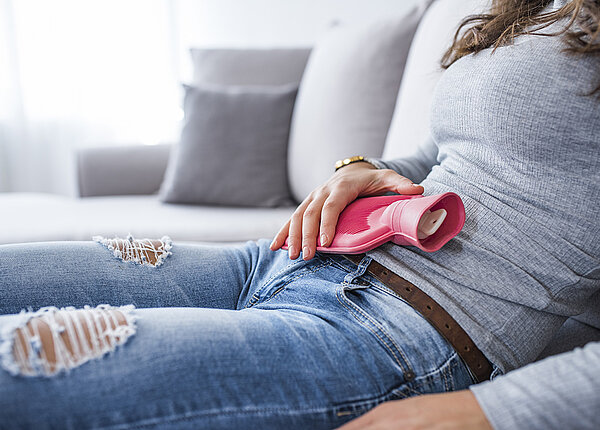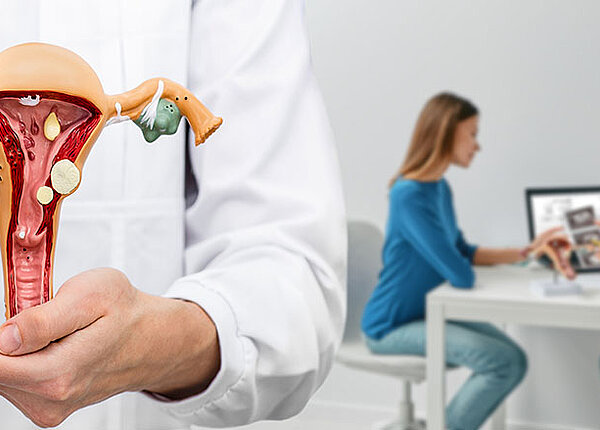English for PTA
MENSTRUAL CRAMPS
Seite 1/1 5 Minuten
Those cramps can be accompanied by nausea, loose stools, headaches, and dizziness. During menstruation, the uterus contracts to expel the uterine lining. Prostaglandins, hormone-like substances involved in pain and inflammation, trigger the contractions. Higher levels of prostaglandins are associated with more severe menstrual cramps. Endometriosis is the result of uterine implanting itself outside the womb, commonly on the fallopian tubes, ovaries, or in the pelvic area. Adenomyosis is caused by uterine tissue growing into the muscular walls of the uterus. Help is at hand at the pharmacy.
Female pharmacy customer: Good morning.
I’m sorry but my German is not that good!
PTA: Good morning. Oh, that’s not a problem. How may I help you?
Well, it’s that time of the month again and this time, the cramps are worse than usual. Is there anything that you can recommend to deal with them?
Certainly, is it okay though if I ask you a few questions first so that I can recommend the most effective remedy?
Sure, no problem. Go ahead.
Might you have fibroids?
No, I went to my gynaecologist last month for my annual check-up. She did an ultrasound and didn’t find any suspicious growths. No signs of polycystic ovarian syndrome, thank goodness.
Where exactly are the cramps? Are they in your lower back, or in the abdomen, or both?
I usually only have them in the abdomen, but this time I’m experiencing them in the lower back as well.
Okay. Have you noticed any difference in discharge, you know, does it smell funny, or is it more than usual?
It seems to be more than usual, but there is no colour change and it isn’t smelly.
Last question: any headaches, dizziness, or nausea?
I have a bit of a headache, but no nausea or dizziness.
I can recommend this very effective remedy. It comes in two types, one with and one without paracetamol. Personally, I find that the one with paracetamol works best. On the one hand, the active ingredient butylscopolamine is very effective at relieving cramps. On the other hand, paracetamol helps to alleviate the pain.
That sounds good, I’ll take it!
What I can also recommend is using a hot-water bottle, or a heated cherry pit pillow as warmth helps to alleviate cramping. Please make sure that you do not take more than six tablets a day, high doses of paracetamol can cause liver damage. Do not take the tablets for longer than three to four days. If your symptoms do not improve within two days or so, or you notice a change in excretion, please consult a gynaecologist.
I’ll do that. Thank you so much for your help.
No problem! You are more than welcome. Goodbye.
Thank you. Bye, bye!
You can find this article on page 116 in DIE PTA IN DER APOTHEKE 02/2022.
Catherine Croghan, Lecturer in English and native speaker
Vocabulary
| menstrual cramps | Menstruationsbeschwerden, -krämpfe |
|---|---|
| throbbing | pochend pulsierend |
| lower back | Kreuz, unterer Rücken |
| lower abdomen | Unterleib |
| severe | stark |
| interfere | beeinträchtigen |
| nausea | Übelkeit |
| loose stools | dünner Stuhl |
| dizziness | Schwindel |
| contract | sich zusammenziehen |
| expel | vertreiben |
| uterine lining | Gebärmutterschleimhaut |
| womb | Gebärmutter |
| fallopian tubes | Eileiter |
| ovaries | Eierstöcke |
| pelvic area | Beckenregion |
| tissue | Gewebe |
| that time of the month | die Tage |
| fibroid | Myom |
| discharge | absondern |
| cherry pit pillow | Kirschkernkissen |












